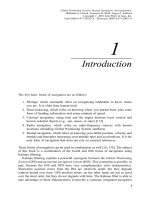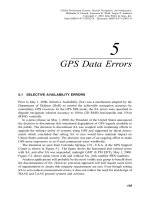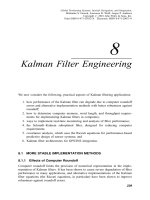GPS - đường dẫn quán tính và hội nhập P2
Bạn đang xem bản rút gọn của tài liệu. Xem và tải ngay bản đầy đủ của tài liệu tại đây (294.14 KB, 21 trang )
2
Fundamentals of Satellite
and Inertial Navigation
2.1 NAVIGATION SYSTEMS CONSIDERED
This book is about GPS and INS and their integration. An inertial navigation unit
can be used anywhere on the globe, but it must be updated within hours of use by
independent navigation sources such as GPS or celestial navigation. Thousands of
self-contained INS units are in continuous use on military vehicles, and an
increasing number are being used in civilian applications.
2.1.1 Systems Other Than GPS
GPS signals may be replaced by LORAN-C signals produced by three or more long-
range navigation (LORAN) signal sources positioned at ®xed, known locations for
outside-the-building location determination. A LORAN-C system relies upon a
plurality of ground-based signal towers, preferably spaced apart 100±300 km, that
transmit distinguishable electromagnetic signals that are received and processed by a
LORAN signal antenna and LORAN signal receiver=processor that are analogous to
the Satellite Positioning System signal antenna and receiver=processor. A represen-
tative LORAN-C system is discussed in LORAN-C User Handbook [85]. LORAN-C
signals use carrier frequencies of the order of 100 kHz and have maximum reception
distances of hundreds of kilometers. The combined use of FM signals for location
determination inside a building or similar structure can also provide a satisfactory
location determination (LD) system in most urban and suburban communities.
9
Global Positioning Systems, Inertial Navigation, and Integration,
Mohinder S. Grewal, Lawrence R. Weill, Angus P. Andrews
Copyright # 2001 John Wiley & Sons, Inc.
Print ISBN 0-471-35032-X Electronic ISBN 0-471-20071-9
There are other ground-based radiowave signal systems suitable for use as part of
an LD system. These include Omega, Decca, Tacan, JTIDS Relnav (U.S. Air Force
Joint Tactical Information Distribution System Relative Navigation), and PLRS
(U.S. Army Position Location and Reporting System). See summaries in [84, pp.
6±7 and 35±60].
2.1.2 Comparison Criteria
The following criteria may be used in selecting navigation systems appropriate for a
given application system:
1. navigation method(s) used,
2. coordinates provided,
3. navigational accuracy,
4. region(s) of coverage,
5. required transmission frequencies,
6. navigation ®x update rate,
7. user set cost, and
8. status of system development and readiness.
2.2 FUNDAMENTALS OF INERTIAL NAVIGATION
This is an introductory-level overview of inertial navigation. Technical details are in
Chapter 6 and [22, 75, 83, 118].
2.2.1 Basic Concepts of Inertial Navigation
Inertia is the propensity of bodies to maintain constant translational and rotational
velocity, unless disturbed by forces or torques, respectively (Newton's ®rst law
of motion).
An inertial reference frame is a coordinate frame in which Newton's laws of
motion are valid. Inertial reference frames are neither rotating nor accelerat-
ing.
Inertial sensors measure rotation rate and acceleration, both of which are vector-
valued variables:
(a) Gyroscopes are sensors for measuring rotation: rate gyroscopes measure
rotation rate, and displacement gyroscopes (also called whole-angle
gyroscopes) measure rotation angle.
(b) Accelerometers are sensors for measuring acceleration. However, accel-
erometers cannot measure gravitational acceleration. That is, an accel-
erometer in free fall (or in orbit) has no detectable input.
10
FUNDAMENTALS OF SATELLITE AND INERTIAL NAVIGATION
The input axis of an inertial sensor de®nes which vector component it measures.
Multiaxis sensors measure more than one component.
Inertial navigation uses gyroscopes and accelerometers to maintain an estimate of
the position, velocity, attitude, and attitude rates of the vehicle in or on which
the INS is carried, which could be a spacecraft, missile, aircraft, surface ship,
submarine, or land vehicle.
An inertial navigation system (INS) consists of the following:
(a) an inertial measurement unit (IMU)orinertial reference unit (IRU)
containing a cluster of sensors: accelerometers (two or more, but usually
three) and gyroscopes (three or more, but usually three). These sensors are
rigidly mounted to a common base to maintain the same relative orienta-
tions.
(b) Navigation computers (one or more) calculate the gravitational accelera-
tion (not measured by accelerometers) and doubly integrate the net
acceleration to maintain an estimate of the position of the host vehicle.
There are many different designs of inertial navigation systems with different
performance characteristics, but they fall generally into two categories:
gimbaled and
strapdown.
These are illustrated in Fig. 2.1 and described in the following subsections.
2.2.2 Gimbaled Systems
2.2.2.1 Gimbals A gimbal is a rigid frame with rotation bearings for isolating
the inside of the frame from external rotations about the bearing axes. If the bearings
could be made perfectly frictionless and the frame could be made perfectly balanced
(to eliminate unbalance torques due to acceleration), then the rotational inertia of the
frame would be suf®cient to isolate it from rotations of the supporting body. This
level of perfection is generally not achievable in practice, however.
Alternatively, a gyroscope can be mounted inside the gimbal frame and used to
detect any rotation of the frame due to torques from bearing friction or frame
unbalance. The detected rotational disturbance can then be used in a feedback loop
to provide restoring torques on the gimbal bearings to null out all rotations of the
frame about the respective gimbal bearings.
At least three gimbals are required to isolate a subsystem from host vehicle
rotations about three axes, typically labeled roll, pitch, and yaw axes.
The gimbals in an INS are mounted inside one another, as illustrated in Fig. 2.1b.
We show three gimbals here because that is the minimum number required. Three
gimbals will suf®ce for host vehicles with limited ranges of rotation in pitch and roll,
such as surface ships and land vehicles. In those applications, the outermost axis is
typically aligned with the host vehicle yaw axis (nominally vertical), so that all three
2.2 FUNDAMENTALS OF INERTIAL NAVIGATION
11
gimbal rotation axes will remain essentially orthogonal when the inner gimbal axes
are kept level and the vehicle rotates freely about its yaw axis only.
A fourth gimbal is required for vehicles with full freedom of rotation about all
three axesÐsuch as high-performance aircraft. Otherwise, rotations of the host
vehicle can align two of the three gimbal axes parallel to one another in a condition
called gimbal lock. In gimbal lock with only three gimbals, the remaining single
``unlocked'' gimbal can only isolate the platform from rotations about a second
rotation axis. Rotations about the third axis of the ``missing'' gimbal will slew the
platform unless a fourth gimbal axis is provided for this contingency.
2.2.2.2 Stable Platforms The earliest INSs were developed in the mid-
twentieth century, when ¯ight-quali®ed computers were not fast enough for
integrating the full (rotational and translational) equations of motion. As an
alternative, gimbals and torque servos were used to null out the rotations of a
stable platform or stable element on which the inertial sensors were mounted, as
illustrated in Fig. 2.1b.
The stable element of a gimbaled system is also called an inertial platform or
``stable table.'' it contains a sensor cluster of accelerometers and gyroscopes, similar
to that of the ``strapdown'' INS illustrated in Fig. 2.1a.
2.2.2.3 Signal Processing Essential software functions for a gimbaled INS
are shown in signal ¯ow form in Fig. 2.2, with blocks representing the major
software functions, and x
1
, x
2
, x
3
representing position components.
The essential outputs of the gimbaled IMU are the sensed accelerations and
rotation rates. These are ®rst compensated for errors detected during sensor-or
Fig. 2.1 Inertial measurement units.
12
FUNDAMENTALS OF SATELLITE AND INERTIAL NAVIGATION
system-level calibrations. This includes compensation for gyro drift rates due to
acceleration.
The compensated gyro signals are used for controlling the gimbals to keep the
platform in the desired orientation, independent of the rotations of the host vehicle.
This ``desired orientation'' can be (and usually is) locally level, with two of the
accelerometer input axes horizontal and one accelerometer input axis vertical. This is
not an inertial orientation, because the earth rotates, and because the host vehicle
can change its longitude and latitude. Compensation for these effects is included in
the gyro error compensation.
The accelerometer outputs are also compensated for known errors, including
compensation for gravitational accelerations which cannot be sensed and must be
modeled. The gravity model used in this compensation depends on vehicle position.
This coupling of position and acceleration creates recognized dynamical behavior of
position errors, including the following:
1. Schuler oscillation of horizontal position and velocity errors, in which the INS
behaves like a pendulum with period equal to the orbital period (about
84.4 min at sea level). Any horizontal INS velocity errors will excite the
Schuler oscillation, but the amplitude of the oscillations will be bounded so
long as the INS velocity errors remain bounded.
2. Vertical-channel instability, in which positive feedback of altitude errors
through the gravity model makes INS altitude errors unstable. For INS
applications in surface ships, the vertical channel can be eliminated. External
water pressure is used for estimating depth for submarines, and barometric
altitude is commonly used to stabilize the vertical channel for aircraft.
After compensation for sensor errors and gravity, the accelerometer outputs are
integrated once and twice to obtain velocity and position, respectively. The position
estimates are usually converted to longitude, latitude, and altitude.
Fig. 2.2 Essential signal processing for gimbaled INS.
2.2 FUNDAMENTALS OF INERTIAL NAVIGATION
13
2.2.3 Strapdown Systems
2.2.3.1 Sensor Cluster In strapdown systems, the inertial sensor cluster is
``strapped down'' to the frame of the host vehicle, without using intervening gimbals
for rotational isolation, as illustrated in Fig. 2.1a. The system computer must then
integrate the full (six-degree-of-freedom) equations of motion.
2.2.3.2 Signal Processing The major software functions performed by
navigation computers for strapdown systems are shown in block form in Fig. 2.3.
The additional processing functions, beyond those required for gimbaled inertial
navigation, include the following:
1. The blocks labeled ``Coordinate transformation update'' and ``Acceleration
coordinate transformation'' in Fig. 2.3, which essentially take the place of the
gimbal servo loops in Fig. 2.2. In effect, the strapdown software maintains
virtual gimbals in the form of a coordinate transformation from the uncon-
strained, body-®xed sensor coordinates to the equivalent sensor coordinates of
an inertial platform.
2. Attitude rate compensation for accelerometers, which was not required for
gimbaled systems but may be required for some applications of strapdown
systems. The gyroscopes and gimbals of a gimbaled IMU were used to isolate
the accelerometers from body rotation rates, which can introduce errors such
as centrifugal accelerations in rotating accelerometers.
2.3 SATELLITE NAVIGATION
The GPS is widely used in navigation. Its augmentation with other space-based
satellites is the future of navigation.
Fig. 2.3 Essential signal processing for strapdown INS.
14
FUNDAMENTALS OF SATELLITE AND INERTIAL NAVIGATION
2.3.1 Satellite Orbits
GPS satellites occupy six orbital planes inclined 55
from the equatorial plane, as
illustrated in Fig. 2.4, with four or more satellites per plane, as illustrated in Fig. 2.5.
2.3.2 Navigation Solution (Two-Dimensional Example)
Receiver location in two dimensions can be calculated by using range measurements
[45].
Fig. 2.4 GPS orbit planes.
Fig. 2.5 GPS orbit phasing.
2.3 SATELLITE NAVIGATION
15
2.3.2.1 Symmetric Solution Using Two Transmitters on Land In this
case, the receiver and two transmitters are located in the same plane, as shown in
Fig. 2.6, with known positions x
1
; y
1
and x
2
; y
2
. Ranges R
1
and R
2
of two
transmitters from the user position are calculated as
R
1
c DT
1
; 2:1
R
2
c DT
2
2:2
where c speed of light (0.299792458 m=ns)
DT
1
time taken for the radio wave to travel from transmitter 1 to the user
DT
2
time taken for the radio wave to travel from transmitter 2 to the user
X ; Yuser position
The range to each transmitter can be written as
R
1
X À x
1
2
Y À y
1
2
1=2
; 2:3
R
2
X À x
2
2
Y À y
2
2
1=2
: 2:4
Expanding R
1
and R
2
in Taylor series expansion with small perturbation in X by
Dx and Y by Dy, yields
DR
1
@R
1
@X
Dx
@R
1
@Y
Dy u
1
; 2:5
DR
2
@R
2
@X
Dx
@R
2
@Y
Dy u
2
; 2:6
where u
1
and u
2
are higher order terms. The derivatives of Eqs. 2.3 and 2.4 with
respect to X ; Y are substituted into Eqs. 2.5 and 2.6, respectively.
Fig. 2.6 Two transmitters with known two-dimensional positions.
16
FUNDAMENTALS OF SATELLITE AND INERTIAL NAVIGATION









